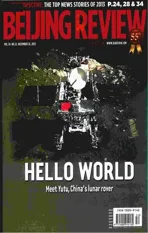Food Security
2013-04-29
Caijing Magazine December 9
On November 29, Chinas National Bureau of Statistics revealed that Chinas grain output reached 601.935 million tons in 2013, up 2.1 percent compared to the previous year. This is the 10th consecutive year that Chinas grain output has increased.
However, the reality is that China is still suffering from a food shortage in spite of the rate of increase. In the past decade—excluding 2008 and 2009, when the grain output slightly surpassed demand—grain output has failed to meet the demands of the Chinese people.
One reason for the gap between demand and production is that China includes soybeans in the figures. Because the imported soybeans have occupied half of the domestic market, the degree of selfsufficiency is lowered by 10 percentage points.
Nevertheless, Chinas three major grains—rice, wheat and corn—are also experiencing increased imports. This is an alarming trend. According to statistics, China imported 19 million tons of the three major grains in 2012. The figure for the first seven months in 2013 reached 11.439 million tons. Moreover, China could surpass Egypt to become the worlds biggest importer of wheat in 2013.
The truth is that the import of major grains has become normal for China. Due to the difficulty in realizing largescale grain production in the short term and the increasing shortage of cultivated land and other resources, Chinas grain production costs have remained high. In addition, the space for an increase in production is narrowing. The current situation cannot be changed in the short term. Ensuring food security is becoming an increasingly urgent issue for China.
Parking Space
Changjiang Daily December 18
The number of vehicles on Beijings roads exceeds 5.4 million, but the city only has 2.76 million regular parking spaces. Currently, over 80 percent of vehicles are parked in irregular spaces, but this doesnt mean there are insufficient parking spaces.
Management of parking spaces is disorganized. Only the traffic units of public security departments have the right to plot out roadside parking spaces, with the toll standards to be ratified by the reform and development departments. Parking tolls are handed to the financial departments. Industry and commerce departments respond to day-to-day operations, and the urban management departments deal with problems. Companies charging for parking spaces, restaurants and hotels close to roadside parking spaces, community administrative departments all consider parking spaces a gold mine. Public resources become a method of illegal profiteering.
It is true that charging for parking could help drive people to choose public transit as an alternative, but it doesnt mean that a city should neglect developing and better managing parking spaces.
Parking space problems are an inevitable pain during urban development, but high fees are definitely not the answer. A city should be capable of holding its vehicles. More and more parking spaces and their management should be made public property again.
Airport Paralysis
Yangcheng Evening News December 17
This year, it was not rare to see an airport paralyzed during bad weather. In many cases, not only did some flights fail to operate normally, but some airports failed to cope appropriately. Passengers who were delayed at the airport lacked food and medical services. There were even violent incidents due to disputes between passengers and airport staff. Its time for airports to carefully examine their services.
Flight delays caused by weather hap- pen frequently. Every airline and airport has a corresponding emergency plan. With efforts to promote common sense and safety knowledge, people would be able to show more understanding and tolerance when there are unexpected circumstances caused by natural disasters during their travels. However, for this to happen, an orderly and well-prepared follow-up services from airlines and airports are needed. Airports and flights might be affected, but emergency plans shouldnt. Recklessness and disorder should be avoided.
Cultural Shift
Oriental Outlook December 5
A hundred years ago, the New Culture Movement, which took place in the mid 1910s and 1920s, called for the creation of a new Chinese culture, and changed the Chinese peoples worldview. Today, culture is again undergoing major changes—this time, the change is brought by new technology and new media.
Technology and media affect the methods of cultural transmission today. Everyone involved in the transmission process can smell the opportunities that new culture transmission methods bring. Famous writers such as Hai Yan, who insists on drawing a line with online literature, wants to enable works to be accessible on the Internet.
Every market has a “first pot of gold” at its beginning stage. This is also the most disorderly stage. On the one hand, this disorder is reflected on the rules and management system of the market. On the other hand, it can offer possibilities for new participants to win.
Literary works, films, TV series, publications and music make up the pillars of our cultural life. What will they become in the new media, new channels and new trends? How will they be produced? How can businesspeople make money from them? How will they provide nutrition for society? All these questions are to be answered with the development of the new movement.
